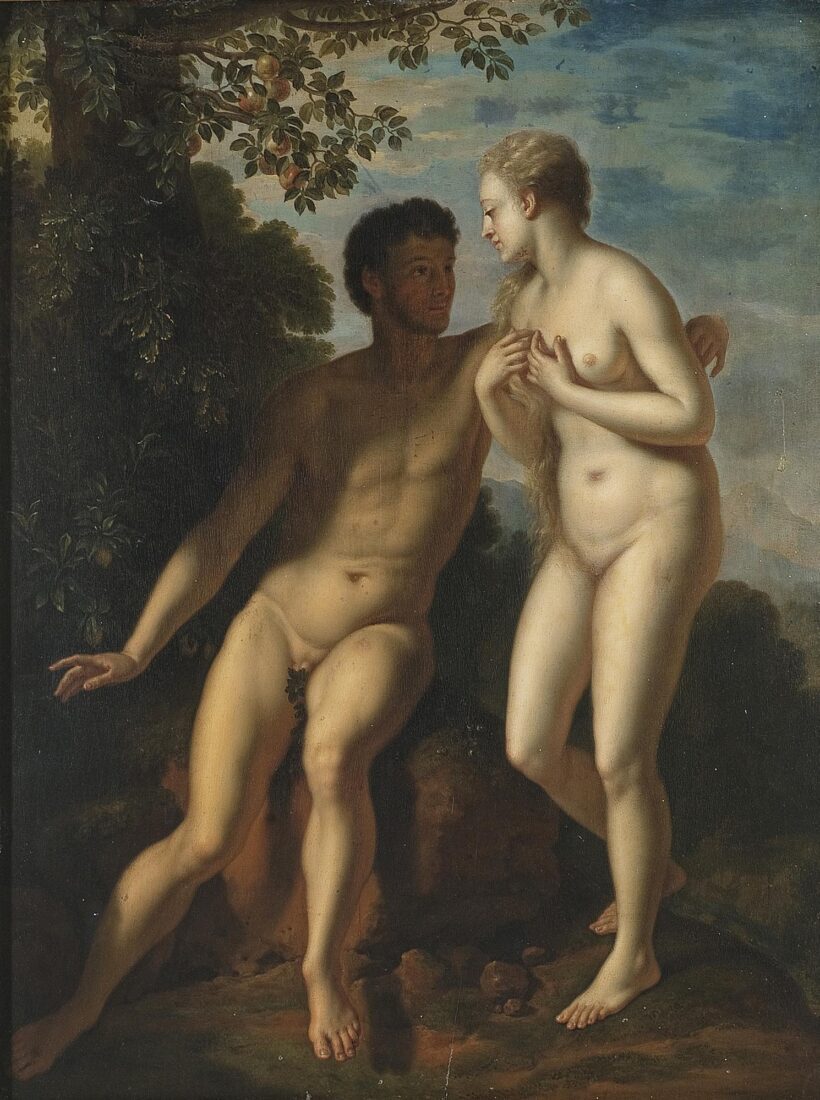We use cookies to make our site work properly, to personalize content and ads, to provide social media features and to analyze our traffic. We also share information about how you use our site with our social media, advertising and analytics partners. Read the Cookies Policy.

Werff Adriaen van der (1659 - 1722)
Adam and Eve
Oil on panel, 50 x 39 cm
Donated by the University
Oil on wood, 50X38 cm. Inv. no. 1047 Gift of the University of Athens
This work has already been studied by Marilena Cassimatis (National Technical University of Athens 150 Years, p. 80), Angela Tamvaki (Pietro Longhi and His Century, p. 80-81), Angela Tamvaki, (The Old Testament in European Painting, p. 20-21). It has attributed to Adriaen van der Werff and has been linked to two other works whose
subject has also been identified as Adam and Eve. One of these is in the Herzog Anton Ulrich-Museum in Braunschweig and bears the inscription, “Chevr vr Werff. fe an 1711” (Rudiger Klessmann (ed.), Herzog Anton Ulrich-Museum Braunschweig. Die hollandischen Gemalde, p. 223). This work is exceptionally close to the work at the National Gallery, specifically in the way the figures are posed, in the rendition of the landscape and, more generally speaking now, in the way the whole composition is realized. The other work is in the Louvre Museum and has been attributed either to Adriaen van der Werff or to his brother, Pieter van der Werff, with whom he collaborated on some of his paintings (Site officiel du musee du Louvre, 1/12/2005). This depiction differs, however, from the two previously mentioned ones in both the pose struck by the figures and the rendering of the landscape. The female figure is holding an apple in her hand and a number of animals are also depicted including a snake, doves and up in the branches of a tree a bird, in all likelihood a parrot. Even though the image in the Louvre with the depiction of the elements mentioned above makes a good case for identifying its subject as Adam and Eve, the work at the National Gallery is far more elliptical. Neither the apple in Eve’s hand nor the animals of Paradise, not even the snake, are depicted, that is, all the elements deemed critical in any reference to the story of Adam and Eve. The absence of these elements has already been noted by the abovementioned scholars, and it has been hypothesized that this work is most probably a rare variation of the theme, referring to the paradisiac state Adam and Eve lived in before the Temptation. At the same time, mention has been made connecting this rendition with certain depictions of Adonis and Aphrodite or even the Judgement of Paris. A number of other depictions could also be thought of as thematically linked, whether they be mythological couples such as Vertumnus and Pomona, or Aphrodite and Eros, or even bucolic couples in idyllic landscapes. In some of these scenes the depicted couple, usually nude and frequently embracing, are placed in nature amid dense, lush vegetation. Besides the interest in the rendering of this specific subject, these scenes also constitute an area where the emphasis could be placed on the rendering of the nude body. Even though iconographically these scenes refer to specific identities, and with varying degrees of clarity, they do, at the same time, belong to a tradition centered on the depiction of amorous couples, mythological in the overwhelming majority of cases, and set in nature. This tradition was particularly widespread in European art during the Renaissance and many examples of it are to be found in the Low Countries. The specific theme of Adam and Eve was also part of a very rich artistic tradition in Western European art in general, and, more
particularly, in the Low Countries during the sixteenth and seventeenth century. Artists such as Raphael, Durer, Titian, Rubens, Jacob Jordaens, Hendrick Goltzius, Cornelis Cornelisz. van Haarlem, among many many others, produced various treatments of the subject of Adam and Eve (see, for example, the entry: Jacob Jordaens. Adam and Eve, in Peter Sutton et al., The Age of Rubens, Boston, Ghent: Museum of Fine Arts, Ludion Press, 1993, p. 349-351; also A. d’Hulst and M. Vandenven, The Old Testament, in Ludwig Burchard. Corpus Rubenianum. Part III. London, New York: Harvey Miller LTD, Oxford University Press, 1989, p. 34-37). The typical rendering would contain characteristic elements, such as the apple in Eve’s hand, the snake, frequently wound around the Tree of the Knowledge of Good and Evil, and various animals and birds, most frequently parrots, hares and monkeys. These elements stand as references both to the Fall and to Paradise itself where Adam and Eve lived before the sin. (For the relationship to the text in Holy Scripture see Genesis, Chapters II, III). But as has already been noted, the work at the National Gallery diverges from the customary treatments of this subject through the austerity shown in its supplementary elements. Mainly, the tree, in all likelihood an apple tree, under which two figures are depicted, constitutes a reference to Adam and Eve and the Tree of Knowledge. Furthermore, the gesture the man is making perhaps refers to Adam’s warning Eve not to eat of the forbidden fruit. Many artists, such as Rubens in his Adam and Eve from 1598-1600, rendered this particular gesture with great expressivity. In any case, the interest of van der Werff seemed to have been primarily focused on the rendering of the nude male and female bodies with the classicistic and idealized characteristics set within a tranquil landscape at twilight, like those landscapes that frequently hosted well-known mythological couples.

